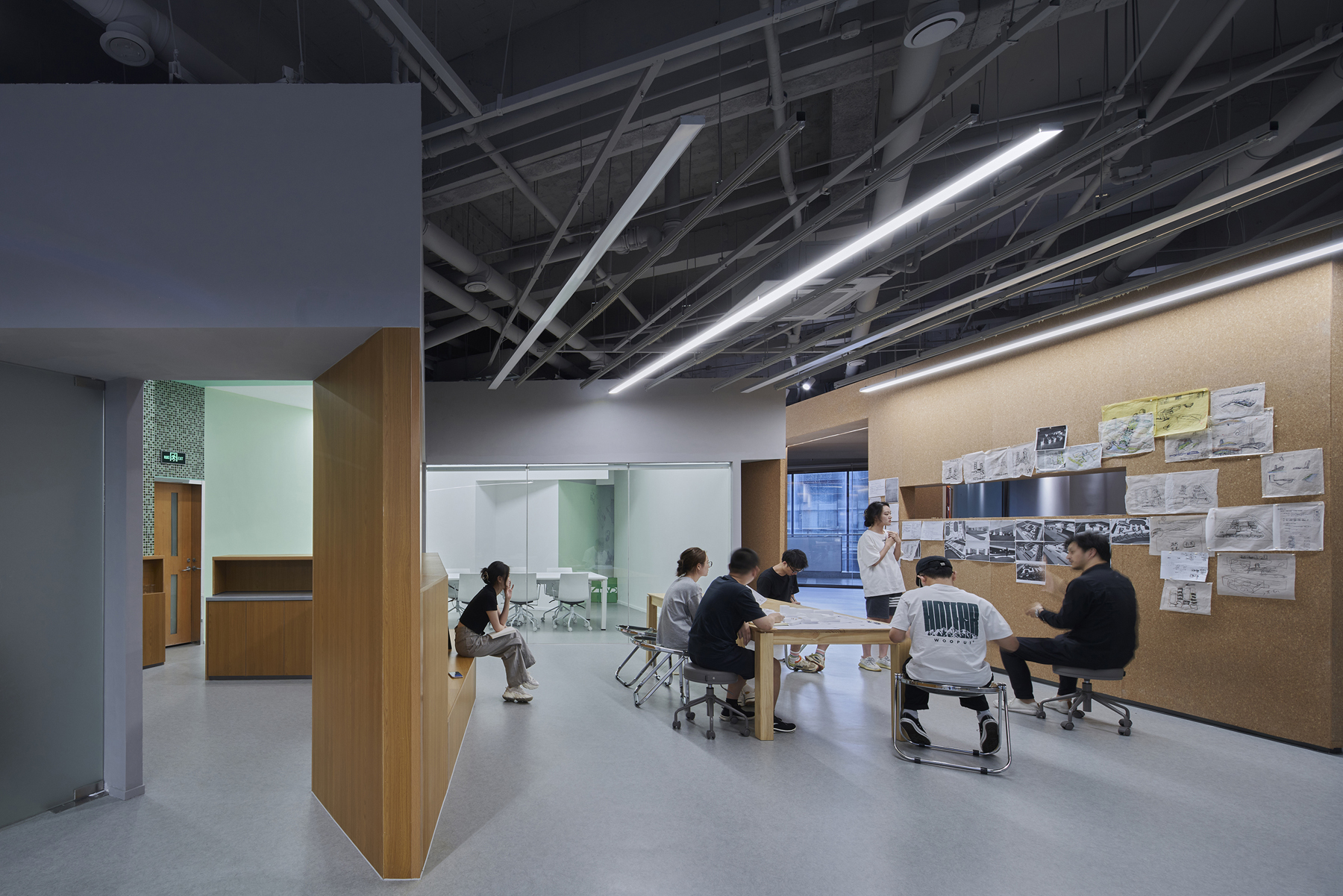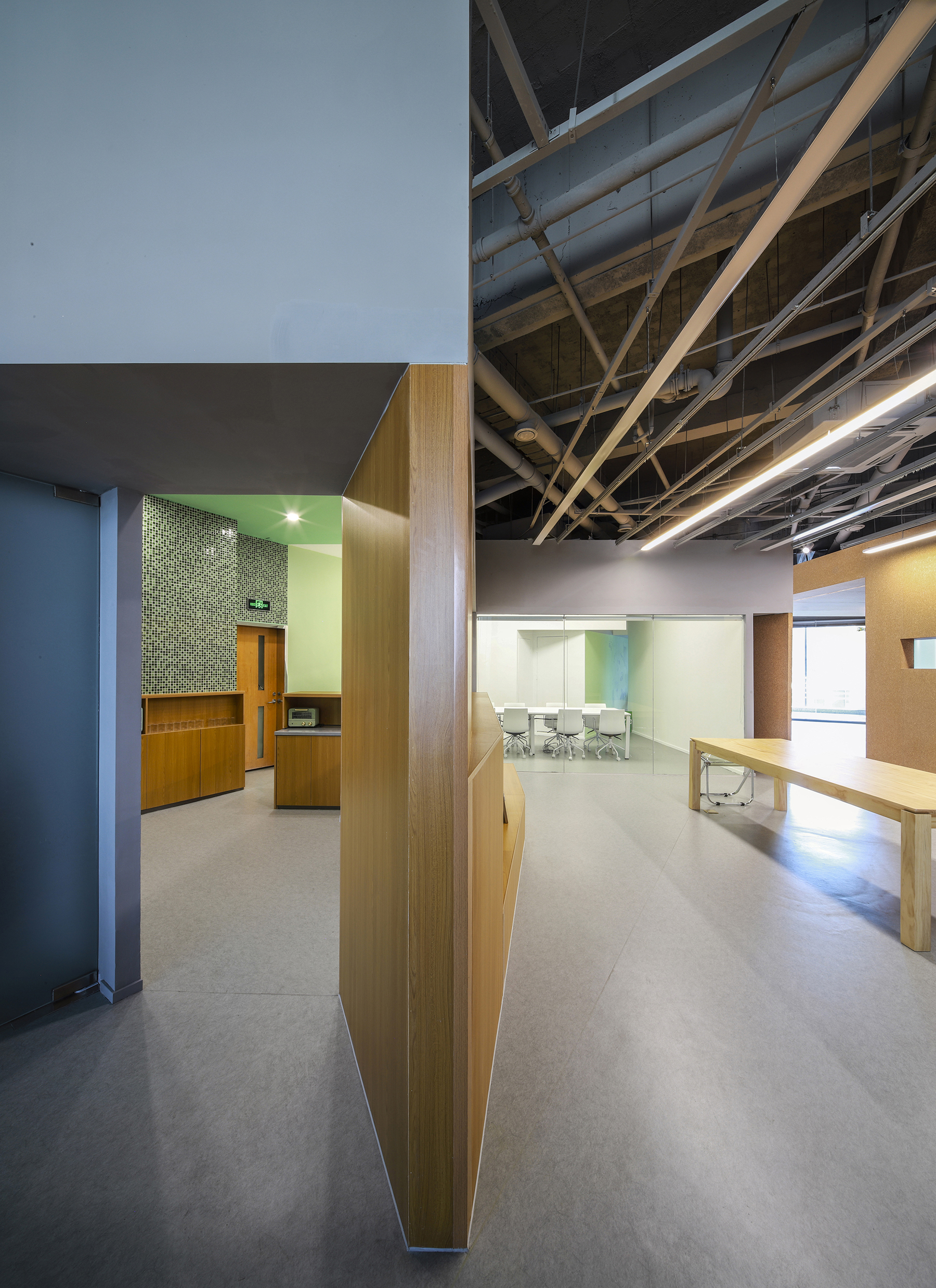
设计单位 STWD十拓建筑
项目地点 江苏苏州
建设时间 2022年
建筑面积 220平方米
不同以往受制于冗长繁复的设计任务书,面对自己的办公空间,同为甲方乙方的我们自问:创造型设计事务所办公空间的核心本质是什么?谜底就藏在谜面里——为了更好地激发创造力。
No longer limited by long design specifications, when met with the task of designing our own workspace we asked ourselves: “What is the key to a creative office space design?” We soon discovered that the answer lies within – “to better encourage creativity, of course.”
创造力源于交流——我们所指的交流,不仅是狭义的人与人的互动交流,更有广义的全方位的交流,包括人与自我、与光线、与时间、与文化的互动。我们将其定义为显性和隐性两种交流方式。
Creativity is a product of communicating with multiple factors in life; it is not only about the interaction between humans, but also one’s relations with themselves, light, time, and culture. Le Corbusier once mentioned that the ideal life is a “balance between solitude and daily social life.”
当柯布谈及理想生活图景时说道:“宁静自处,又与人天天交往”,其状态受用于日常工作同样合理——在外界的、热闹的、集体的显性交流表征之下,办公场所内还暗藏着一个秘而不宣的个体性空间,它于时空的隐微之处构筑出私人精神领地。显性交流与隐性交流,它们如同诗文的互辞、硬币的两面,共同建构出一个细密复杂、不断激发创意与可能的交流网络。
This condition that Corbusier describes is just as applicable to one’s daily work life – In addition to a lively and collective area of communication at the front of the office, a secret, individual space is hidden deep inside the workplace, creating a solitary spiritual space. In which, like the interlocutions of poetry, or the two sides of a coin, explicit and implicit communication work together to generate a complex yet creativity-inspiring network.



然而无论是从20世纪中期资本逐利下形成的格子间,还是如今悄然兴起的开放式办公空间,它们或而强调清晰的流线与互不干扰的办公空间,或而强调集体性交往下的沟通与创造。我们既反对泾渭分明的功能限制,也反对仅关乎集体性的交往空间。我们主张多元流动的空间形式,主张集体可交流、私人能自处的办公场所。
Yet, whether it is the cubicle-styled offices formed from profit-driven capital in the mid-20th century or the spacious office style that has subtly increased in popularity in recent years – they either emphasize clear streamlines and non-interfering workspaces or put a vast focus on creation under extremely collective communication. We oppose both designs that produce clear-cut communication limits and also those that only allow cooperative work; our aim is to create an office space that encourages diverse forms of communication, where solitude and collectiveness can coexist.
设计团队通过显性与隐性两种交流方式为线索,用明暗线交织的方式组织空间构成,试图在办公空间中营造出一个关乎集体与自我、身体与心灵的多重想象。
With the concept of explicit communication and implicit communication as the core of our design, our team hoped to fabricate a multi-tiered environment driven by the relationship between a collective one’s self, body, and soul. Thus, for our spacial composition, we combined the two forms of communication through a focus on both an overt and covert design concept.

明线
—
显性交流空间构成
STWD新办公室是一个长24米、宽11米、层高4.8米的南北狭长的扇形盒。我们从资料收集、设计讨论、模型制作、成果绘制这四种纵贯建筑师工作始终的状态出发,利用一条由南至北的折墙与前厅六面亭重置空间,使工作状态公开化与交流化,满足集体显性交流。
The new STWD office is 24 meters long, 11 meters wide, and 4.8 meters high, and it is fan-shaped with long and narrow east and west sides. We began our work by considering the four longitudinal tasks that accompany every architectural process: information collection, design discussions, model making, and drawing production In the end, we designed a wall that folds from the east to the west and a six-faced pavilion to create a resetting space within the vestibule, making the workspace open to explicit communication.

离散而偏转布置的片墙分隔出了大小空间,包容了阅读、展览、讨论等多元功能。大小空间借片墙的错位相互分隔又相互渗透,创造出了流动、多元、暧昧的空间属性,在“隔而未隔,界而未界”中隐喻了一种横跨公开与遮蔽、开放与内聚的矛盾。
The discrete yet deflected placement of the walls produces multiple different spaces with varying sizes, allowing there to be areas designated for diverse functions such as reading, exhibition, and discussions. These spaces draw on the interlacing placement of the walls to both separate and permeate each other, generating a dynamic, diverse and ambiguous spacial attribute that is “separated yet not separated; bounded yet not bounded”, metaphorizing a contradiction between publicity and privacy, and cohesion and division.
前厅由两块展开的片墙打造出活动沙龙及日常讨论的开放地,而人群又能于偏转片墙创造的围合感中获得内聚与亲近的身体感知。它同时作为对外展览空间,犹如一个活的舞台,消弭了室内外边界,而叠合交错的片墙扩大了空间的纵深感与丰富性,又避免了办公场景悉数入目。狭缝般的路径由亭下片墙相互交掩而生,暗藏了一座阅览室,人在其中受庇于软木包裹的片墙及波浪般绵延的书脊,产生了安全、自在的空间体验。
The vestibule consists of two deflected walls to create an open space for activity salons and daily discussions. In this enclosure, people can gather to enjoy a sense of cohesion and closeness. This space also works as an exhibition area, like a living stage that has eliminated the boundary between the interior and exterior parts of the office. The overlapping and staggered walls also expand the depth and richness of the space whilst blocking the view of the interior office. The walls below the pavilion create a slit path, concealing a reading room that comfortably shelters people within cork-wrapped walls and the wavy spine of books, which yields an easing spacial experience.




折墙与亭下片墙创造了流动、含蓄、漫游式的空间结构,让原始直白的直线型流线转变为可供人游戈穿行的折线型回环流线,也一并构筑出了从非正式日常对谈到正式群组会议的交流网络——中部开放大桌如同腹地,作为午间休息时供人聚会饮茶,作为手工模型制作台时将吸引同事逗留交流获取灵感,作为小组讨论的场地时则会引来六面亭逡巡徘徊的个体加入……此间种种,提升了集体偶发性交流的可能。
The folded walls and walls beneath the pavilion create a dynamic, tacit, and roaming spacial structure, which transforms the original straight streamlines into a curved loop that people can travel through, and also established a communication space that can be used for both informal daily conversations and formal group meetings – For instance, the large central table can be utilized for many purposes: it can be used during lunch breaks for people to gather and drink tea, and also as a model-making table to attract colleagues to linger and exchange ideas. A group discussion may then lure other individuals wandering around the pavilions to join in, which greatly raises the possibility of unplanned collective communication that can often result in the generation of great ideas.




暗线
—
隐性交流知觉感知
人通过自身官能感知空间,陈从周先生在《说园》提到园有静观、动观与之分,静者“宛然如画”,动者“移步换影”。静态的凝视与动态的遐思可以体察同一个空间中的不同情境。如果说明线的布置是对山水园林画卷的整体把握,那么暗线就像执笔者遁入画中于隐微之处切身打造内在寂静的空间。
People perceive space through their senses. Mr. Chen Congzhou mentioned in “Talking About Gardens” that gardens can either be static like a single painting or appear dynamic and vary in every corner. A shrewd combination of the static gaze and the dynamic reverie can offer people various experiences within the same space – For example, a painting-like depiction of a garden’s overall landscape can be depicted through an overt concept, while a covert concept can portray a hidden place in the painting that the painter has established themselves.
静观:物我两忘
我们在折墙与亭下设置窗洞,利用窗洞叠合空间、穿透视线。窗洞表明了里与外,分离了此在与他处,使情境脱离真实。当人们坐立于折墙下的茶水间、会议室、亭下狭缝中的图书馆,透过窗洞望去,随即创造了一种窥探意味下的人与场景的对视,在看与被看之间,将使用者从日常中抽离成为空间的旁观者,或而得到极大的感悟与感动。
We set up window openings under the folded wall and pavilion, and utilized them to create overlaps in space and as openings for further visual perception. The window openings create a distinction between the interior and exterior, separate areas from each other, and erect a sense of surrealism. When people sit down in slots beneath the folded wall—such as in the tea area, conference area, or library area – and look through the openings, they’ll develop an optical relationship with the space around them. Between seeing and being seen, one is miraculously pulled out of their daily practices to become a spectator of the space around them.





动观:步移景异,意随景生
片墙的交织错综混沌了完整而具象的空间感知,人在回环曲折中穿行漫游,沿路不断感知亭下排放的模型、累积并置于软木板上的草图,感知光束的柔软、阴影的幽暗、层叠厚墙的粗犷与狭窄甬道的秘密。
The interweaving of the walls generates a complete and concrete spacial perception. As people wander through the twist and turns of these walls, a range of fascinating gadgets will accompany their path—including models under the pavilion, design sketches on the corkboard, and the softness of light beams, the darkness of shadows, the sturdiness of the thick walls, and the mysteries hidden within the narrow corridors.
景随步移而同时意随景生,身体的行走、视线的游动带动了自我在意识迷宫中回荡,唤醒了昨日草图上切片式的想法及无数个过去叠合的个体记忆。此时“步移”变成了一种线索,连接了现实与意识的两端,绵延了时间、空间与个人经验,从而突破时空的疆域,获得了无垠于“此刻、此在”的内心感受。
With each step one takes, the scene before them will change, and their thoughts will follow. The movement of the person’s body and the wandering of their sight will then drive the person’s consciousness to reverberate within them, perhaps awakening thoughts on yesterday’s design sketches and countless other memories from their past. Now, one’s movement becomes a key that unlocks the portal between reality and the human conscience, extending time, space, and personal experiences, thus breaking through the boundaries of the atmosphere to bring about a sense of “here and now”.





流动的空间布局创造了叶脉般细密多元的交流网络,使组织性联系发展成了自发性联系;使集体交流的表征下不断涌动着个体的情感与凝视;使有与无、显与隐、整体与局部、汇集与游离、他者与自我、交流与反思,在一个空间中得到平衡与统一。
The STWD office’s flowing spacial structure creates a diverse and exquisite communication network that develops organizational connection into spontaneous connection, and maintains a balance between an individual’s emotions and their gaze with contrasts in presence, visibility, proportion, compactness, external relationships, communication, and thought.


完整项目信息
项目名称:STWD十拓建筑办公室
项目类型:室内
项目地点:江苏苏州
设计单位:STWD十拓建筑
主创建筑师:王纲
设计团队完整名单:彭辉、费林杰、殷嘉琪、刘飞、王宁、王烨
设计时间:2022年
建设时间:2022年
建筑面积:220平方米
施工:苏州市易高设计营造有限公司
摄影师:薛亮、STWD
版权声明:本文由STWD十拓建筑授权发布。欢迎转发,禁止以有方编辑版本转载。
投稿邮箱:media@archiposition.com
上一篇:支撑与悬浮:武汉高科医疗器械先进制造园共享客厅 / UAO瑞拓设计
下一篇:柏林库里多功能办公园区 / TCHOBAN VOSS Architekten